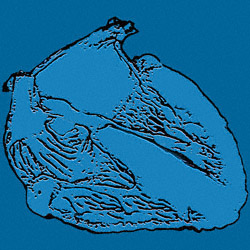
Cardiovascular pathology
Cardiovascular pathology is a subspecialty of pathology dedicated to
the study of diseases that affect the heart and vessels from early development
to senescence. This subspecialty focuses on the characterization
of congenital
heart malformations, diseases of the cardiac muscle (cardiomyopathy),
the cardiac
valves (mitral, aortic, tricuspid and pulmonic), conduction
system (sinoatrial and atrioventricular nodes, His bundle and Purkinje
system), pericardium and
the vascular system including arteries and veins. As any organ,
the heart is a complex organ made of many specialized types of subsystems
which have a distinct morphologic appearance. These morphologic features
change as a function of maturation of the organ and can also change in
disease states. These diverse cardiac tissues also can give origin to benign
and malignant tumors
of the heart. Other components of the cardiovascular system such as
the arteries and veins are also involved by disease processes. The
pathology of the aorta, the pulmonary
artery, systemic arteries and the
great
veins and systemic veins is also within the scope of cardiovascular
pathology.
This web site is organized by topics centered around the morphologic features that define the diseases of the heart and blood vessels. In some instances the morphology needs to be correlated with clinical, physiologic or genetic information to ascertain the diagnosis. Extensive illustration of the normal cardiac structure as well as cardiovascular pathology entities is presented throughout the site in the form of photographs, illustrations and 3d models and animations. References to peer reviewed literature, textbooks on the subject and useful links to web sites are used.
Cardiomyopathy and genetic diseases.
The pathology of the cardiovascular system includes diseases that primarily
affect the heart muscle cells (also called myocytes) and are generally
known as cardiomyopathies. According to the World Health Organization
(1) The cardiomyopathies can be acquired (infectious, toxic, autoimmune,
iatrogenic) or have a genetic basis. From
the morphologic standpoint the have been classified into four main categories,
dilated cardiomyopathy (DCM), hypertrophic (HCM), restrictive (RCM) and
arrhythmogenic right ventricular dysplasia/cardiomyopathy (ARVD / ARVC). However
a trend to classify them on the basis of their genetic causes exists and
is the basis for a new proposal (2).
Congenital malformations and acquired diseases of the heart and vascular system
Genetic defects have been described in each one the 4 morphologic
types of cardiomyopathy. Congenital malformations have also been
associated with genetic alterations, but in many instances there is no
specific mutation or chromosomal alterations found. Genetic diseases
can also affect the vessels either as intrinsic structural problems in
the vessel wall (in vessels such as the aorta) or by altering the metabolism
of the vessel (like in atherosclerosis).
In other instances the pathology of the heart and vessels is modified by therapeutic procedures (angioplasty) or devices (stents, balloon pumps, prosthetic valves, prosthetic vessels / conduits and ventricular assist devices (also known as artificial hearts))



